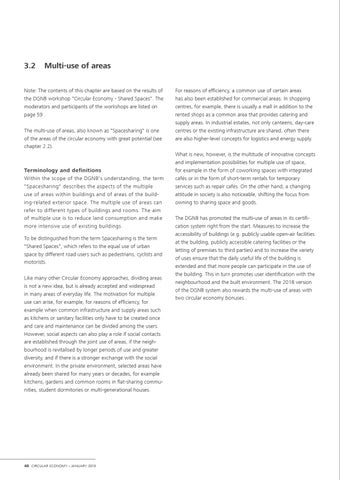3.2 Multi-use of areas Note: The contents of this chapter are based on the results of the DGNB workshop "Circular Economy - Shared Spaces". The moderators and participants of the workshops are listed on page 59 . The multi-use of areas, also known as "Spacesharing" is one of the areas of the circular economy with great potential (see chapter 2.2).
Terminology and definitions Within the scope of the DGNB's understanding, the term "Spacesharing" describes the aspects of the multiple use of areas within buildings and of areas of the building-related exterior space. The multiple use of areas can refer to different types of buildings and rooms. The aim of multiple use is to reduce land consumption and make more intensive use of existing buildings. To be distinguished from the term Spacesharing is the term "Shared Spaces", which refers to the equal use of urban space by different road users such as pedestrians, cyclists and motorists. Like many other Circular Economy approaches, dividing areas is not a new idea, but is already accepted and widespread in many areas of everyday life. The motivation for multiple use can arise, for example, for reasons of efficiency, for example when common infrastructure and supply areas such as kitchens or sanitary facilities only have to be created once and care and maintenance can be divided among the users. However, social aspects can also play a role if social contacts are established through the joint use of areas, if the neighbourhood is revitalised by longer periods of use and greater diversity, and if there is a stronger exchange with the social environment. In the private environment, selected areas have already been shared for many years or decades, for example kitchens, gardens and common rooms in flat-sharing communities, student dormitories or multi-generational houses.
48 CIRCULAR ECONOMY – JANUARY 2019
For reasons of efficiency, a common use of certain areas has also been established for commercial areas. In shopping centres, for example, there is usually a mall in addition to the rented shops as a common area that provides catering and supply areas. In industrial estates, not only canteens, day-care centres or the existing infrastructure are shared, often there are also higher-level concepts for logistics and energy supply. What is new, however, is the multitude of innovative concepts and implementation possibilities for multiple use of space, for example in the form of coworking spaces with integrated cafĂŠs or in the form of short-term rentals for temporary services such as repair cafĂŠs. On the other hand, a changing attitude in society is also noticeable, shifting the focus from owning to sharing space and goods. The DGNB has promoted the multi-use of areas in its certification system right from the start. Measures to increase the accessibility of buildings (e.g. publicly usable open-air facilities at the building, publicly accessible catering facilities or the letting of premises to third parties) and to increase the variety of uses ensure that the daily useful life of the building is extended and that more people can participate in the use of the building. This in turn promotes user identification with the neighbourhood and the built environment. The 2018 version of the DGNB system also rewards the multi-use of areas with two circular economy bonuses..
